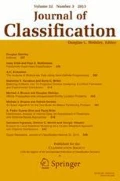Abstract
The Ward error sum of squares hierarchical clustering method has been very widely used since its first description by Ward in a 1963 publication. It has also been generalized in various ways. Two algorithms are found in the literature and software, both announcing that they implement the Ward clustering method. When applied to the same distance matrix, they produce different results. One algorithm preserves Ward’s criterion, the other does not. Our survey work and case studies will be useful for all those involved in developing software for data analysis using Ward’s hierarchical clustering method.
Similar content being viewed by others
References
ANDERBERG, M.R. (1973), Cluster Analysis for Applications, New York: Academic.
BATAGELJ, V. (1988), “Generalized Ward and Related Clustering Problems”, in Classification and Related Methods of Data Analysis, ed. H.H. Bock, Amsterdam: North-Holland, pp. 67-74.
BENZÉCRI, J.P. (1976), L’Analyse des Données, Tome 1, La Taxinomie (2nd ed.), Paris: Dunod.
BRUYNOOGHE, M. (1977), “Méthodes Nouvelles en Classification Automatique des Données Taxinomiques Nombreuses”, Statistique et Analyse des Données, 3, 24-42.
CAILLIEZ, F., and PAGÈS, J.-P. (1976), Introduction à l’Analyse des Données, SMASH (Société de Mathématiques Appliquées et Sciences Humaines).
FISHER, R.A. (1936), “The Use of Multiple Measurements in Taxonomic Problems”, Annals of Eugenics, 7, 179-188.
GOWER, J.C. (1966), “Some Distance Properties of Latent Root and Vector Methods Used in Multivariate Analysis”, Biometrika, 53, 325-338.
JAIN, A.K., and DUBES, R.C. (1988), Algorithms for Clustering Data, Englewood Cliffs NJ: Prentice-Hall.
JAMBU, M. (1978), Classification Automatique pour l’Analyse des Données. I. Méthodes et Algorithmes, Paris: Dunod.
JAMBU, M. (1989), Exploration Informatique et Statistique des Données, Paris: Dunod.
KAUFMAN, L., and ROUSSEEUW, P.J. (1990), Finding Groups in Data: An Introduction to Cluster Analysis, New York: Wiley.
LANCE, G.N., and WILLIAMS, W.T. (1967), “A General Theory of Classificatory Sorting Strategies. 1. Hierarchical Systems”, Computer Journal, 9(4), 373-380.
LEGENDRE, P., and FORTIN, M.-J. (2010), “Comparison of the Mantel Test and Alter-native Approaches for Detecting Complex Relationships in the Spatial Analysis of Data”, Molecular Ecology Resources, 10, 831-844.
LEGENDRE, P. (2011), “const.clust Space- and Time-Constrained Clustering Pack-age”, http://adn.biol.umontreal.ca/~numericalecology/Rcode/
LEGENDRE, P., and LEGENDRE, L. (2012), Numerical Ecology (3rd. English ed.), Amsterdam: Elsevier.
LE ROUX, B., and ROUANET, H. (2004), Geometric Data Analysis: From Correspon dence Analysis to Structured Data Analysis, Dordrecht: Kluwer.
MURTAGH, F. (1983), “A Survey of Recent Advances in Hierarchical Clustering Algorithms”, The Computer Journal, 26, 354-359.
MURTAGH, F. (1985), Multidimensional Clustering Algorithms, Vienna: Physica-Verlag.
MURTAGH, F. (1992), “Comments on: Parallel Algorithms for Hierarchical Clustering and Cluster Validity, IEEE Transactions on Pattern Analysis and Machine Intelligence, 14, 1056-1057.
MURTAGH, F. (2000), “Multivariate Data Analysis Software and Resources”, http://www.classification-society.org/csna/mda-sw.
MURTAGH, F. (2005), Correspondence Analysis and Data Coding with R and Java, Boca Raton FL: Chapman & Hall/CRC.
ORLÓCI, L. (1967), “An Agglomerative Method for Classification of Plant Communities, Journal of Ecology, 55, 193-206.
SZÉKELY, G.J., and RIZZO, M.L. (2005), “Hierarchical Clustering Via Joint Between-Within Distances: Extending Ward’s Minimum Variance Method”, Journal of Classification, 22(2), 151-183.
WARD, J.H. (1963), “Hierarchical Grouping to Optimize an Objective Function”, Journal of the American Statistical Association, 58, 236-244.
WISHART, D. (1969), “An Algorithm for Hierachical Classifications”, Biometrics 25, 165-170.
XPLORE (2007), Version 4.8, Collaborative Research Center 649, Humboldt-Universität, Berlin, Germany, http://sfb649.wiwi.hu-berlin.de/fedchomepage/xplore.php.
Author information
Authors and Affiliations
Corresponding author
Additional information
We are grateful to the following colleagues who ran example data sets in statistical packages and sent us the results: Guy Cucumel, Pedro Peres-Neto and Yves Prairie. Our thanks also to representatives of Statistica, Systat and SAS who provided information on the Ward algorithm implemented in their package.
Rights and permissions
About this article
Cite this article
Murtagh, F., Legendre, P. Ward’s Hierarchical Agglomerative Clustering Method: Which Algorithms Implement Ward’s Criterion?. J Classif 31, 274–295 (2014). https://doi.org/10.1007/s00357-014-9161-z
Published:
Issue Date:
DOI: https://doi.org/10.1007/s00357-014-9161-z




